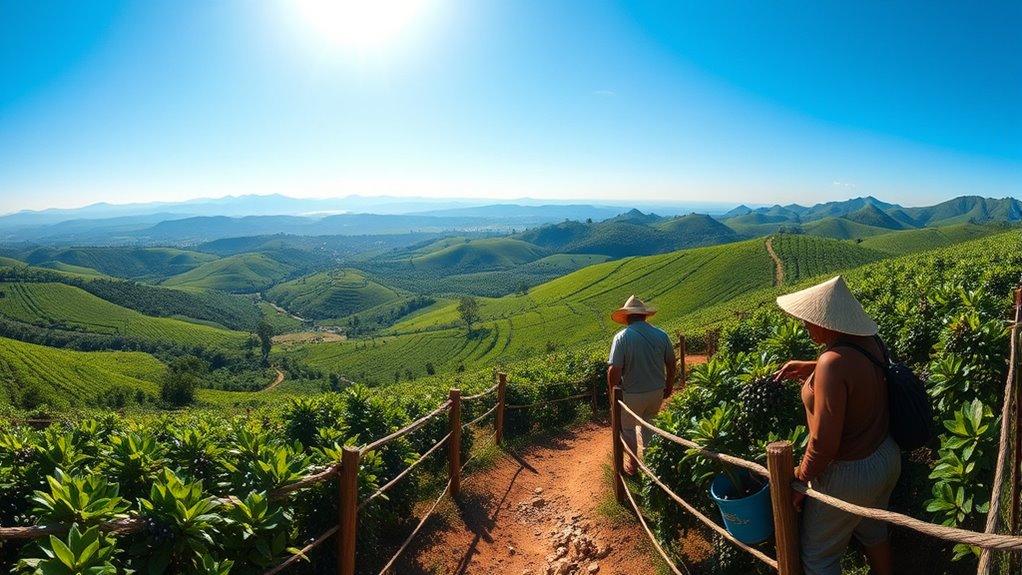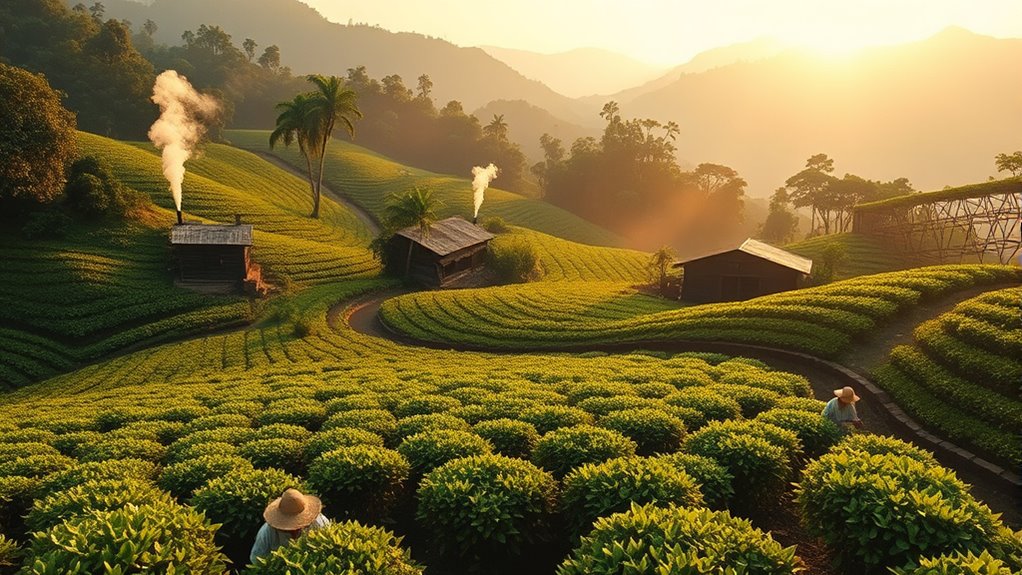In the 19th century, Brazil’s rise to coffee dominance began as a small crop with huge economic potential. You’ll see how innovations in machinery and infrastructure improved production and boosted exports. Migrant workers and new land practices transformed society, creating wealth and social change. Government and private investments strengthened Brazil’s global role. To discover how these shifts shaped the nation’s economy and society, explore these fascinating developments further.
Key Takeaways
- Brazil recognized coffee’s economic potential in the 19th century, transforming it into a vital driver of national growth.
- Adoption of technological innovations like mechanized pulping and irrigation increased yields and reduced costs.
- Expansion of railroads and port infrastructure facilitated efficient transportation and export of coffee.
- Migration of rural and foreign laborers altered social structures and contributed to social complexity.
- Government and private investments in infrastructure and technology reinforced Brazil’s dominance in the global coffee market.

Brazil’s journey to coffee dominance began in the 19th century when it recognized the crop’s immense economic potential. At that time, coffee quickly transformed from a minor crop into a essential driver of the country’s economy, shaping socioeconomic impacts that would influence Brazil for decades. As coffee plantations expanded, they brought about significant social changes: small farmers and large landowners alike saw their fortunes rise, creating a new class of wealthy coffee barons. This surge in coffee production attracted a growing workforce, often composed of laborers migrating from rural areas or even abroad, which altered the social fabric of regions like São Paulo and Minas Gerais. These socioeconomic impacts laid the foundation for Brazil’s economic transformation, positioning coffee as a backbone of national growth.
Alongside these social shifts, technological innovations played a fundamental role in scaling up production and improving efficiency. Early on, farmers adopted new methods for cultivating and processing coffee, such as mechanized pulping and improved irrigation techniques. These innovations allowed producers to increase yields while reducing costs, making Brazilian coffee more competitive on the global market. Railroads and ports expanded rapidly during this period, enabling faster transportation of coffee beans from inland plantations to export hubs. This infrastructure development was driven by a desire to meet international demand and facilitated Brazil’s emergence as a dominant coffee exporter. Additionally, the adoption of improved processing techniques further enhanced the quality and consistency of Brazilian coffee, solidifying its reputation worldwide.
You also notice how technological progress influenced land use and labor practices. The introduction of steam-powered machinery and more efficient harvesting techniques reduced reliance on manual labor, although it also intensified the demand for migrant workers, including many from Europe. These workers were often subjected to harsh conditions, which added a layer of social complexity to the growing coffee industry. Despite these challenges, technological innovations proved essential for Brazil to increase its coffee output and meet the rising global appetite for the beverage.
Furthermore, the economic benefits of coffee cultivation prompted the government and private investors to support infrastructure projects and technological advancements. These efforts created a cycle of growth that reinforced Brazil’s position in the world coffee trade. Your understanding of this period reveals how technological innovations didn’t just boost productivity; they also reshaped social hierarchies and economic structures across the country. By combining social change with technological progress, Brazil set itself on a path to becoming the world’s leading coffee producer, a status it continues to hold today. The synergy of these factors cemented coffee’s role as a cornerstone of Brazil’s economic and social development during the 19th century.
Frequently Asked Questions
How Did Brazilian Coffee Impact Global Trade Routes?
Brazilian coffee transformed global trade by boosting economic influence and reshaping trade routes. You see, as Brazil increased coffee exports, it became a key player in international markets, prompting traders to develop new shipping routes and ports. This shift elevated Brazil’s role in global trade networks, making coffee a essential commodity. Consequently, the global economy benefited from Brazil’s coffee boom, influencing trade patterns and economic relationships worldwide.
What Were the Social Effects of Coffee Cultivation on Local Communities?
Think of coffee as a seed that transforms communities. You see, as coffee cultivation expands, it reshapes labor dynamics, often increasing reliance on enslaved and immigrant workers. This shift sparks community transformations—some towns flourish, others face social tensions. For local communities, coffee’s rise becomes a symbol of economic opportunity and hardship intertwined, shaping identities and social structures in profound ways that still echo today.
Which Technological Innovations Boosted Coffee Production Efficiency?
You see that mechanization advancements and improved plantation infrastructure substantially boosted coffee production efficiency. Machines like the coffee hopper and sorting equipment sped up harvesting and processing, reducing labor needs. Enhanced infrastructure, such as better roads and drainage systems, allowed faster transportation and cultivation. These innovations helped you increase yield, lower costs, and meet rising global demand, fueling Brazil’s rise as a coffee powerhouse in the 19th century.
How Did Brazil Maintain Its Dominance Amid Global Competition?
You maintain Brazil’s dominance by leveraging strategic economic policies, investing in infrastructure, and fostering innovation. You adapt to changing global markets by diversifying exports and strengthening trade relationships. You manage labor dynamics through a mix of skilled and coerced labor, ensuring steady production. By staying flexible and proactive, you secure your position as a leading coffee producer, effectively countering international competitors and capitalizing on your unique advantages.
What Environmental Challenges Arose From Coffee Expansion in Brazil?
You face environmental challenges from coffee expansion in Brazil, including deforestation concerns and soil degradation. As you increase coffee plantations, forests are cleared, harming ecosystems and reducing biodiversity. Intensive farming wears out the soil, making it less fertile and increasing the need for chemicals. These issues threaten sustainable growth, urging you to find ways to balance coffee production with environmental preservation.
Conclusion
So, here you are, marveling at Brazil’s rise to coffee dominance, thinking it was all smooth sailing. But isn’t it ironic? It was the very struggles and setbacks that pushed Brazil to the top, turning obstacles into opportunities. Now, as you sip your coffee, remember—what once seemed like failures actually brewed the future of Brazil’s coffee empire. Sometimes, the sweetest victories come from the most bitter beginnings.









